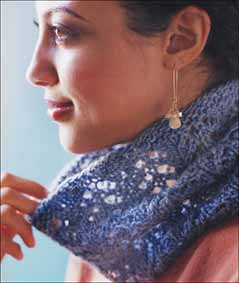Wendy Johnson has been on quite the roll for the last couple of years. Her excellent toe-up sock books contain lovely patterns and lots of good technical advice. Her latest,
Wendy Knits Lace: Essential Techniques and Patterns for Irresistible Everyday Lace
was released this past summer. I am rather behind in my book reviews (well, okay, I'm behind in just about everything) but I didn't want to let this one pass without giving you all a look -- it's such a pretty book with gorgeous patterns in it.
"Wendy Knits Lace" is brought to you by our friends at Potter Craft, and like Wendy's prior books, it's a paperback, with fold-in covers, with glorious color throughout. "Wendy Knits Lace" is a little bigger than her two sock books, at around 8.5 by 11 inches, with approximately 144 pages, MSRP $22.99 (available for $15.63 as of the time of this writing through the link above). The first 38 pages or so are devoted to technical material, and the remainder of the book contains 20 patterns. Let's take a closer look.
Wendy starts with an introduction explaining her approach to lace. While she began by making airy shawls from cobweb yarn, she came to realize that those garments weren't very durable and therefore weren't practical for everyday wear.
The pieces I use over and over again are sturdier lace. The shawls and scarves I knit from slightly heavier lace-weight yarns and sock yarns, for example, are the ones I wear all winter long. I like the idea of knitting pieces that are sturdy and serviceable whiel at the same time lacy and pretty -- lace for everyday life.
She then instructs the reader that the patterns used in the book were knit with "heavier" yarns, meaning yarns other than truly cobweb-weight: heavier lace yarns, and sock through worsted weight yarns.
Deirdre Sweater
Chapter 1 begins with lace knitting basics. Wendy starts by talking about needles, focusing on the material the needles are made from; the pointiness of the tip; and the smoothness of the join (she uses circular needles for lace almost exclusively). She then discusses yarn choice, warning against cotton and acrylic (acrylic because it does not block well, and cotton due to its inelasticity). Wendy goes on to explain the basics of chart reading; the importance of swatching and gauge; and the critical step of blocking. She covers the use of lifelines; how to use stitch markers to keep track of patterns; and tips for fixing missed stitches (very helpful!).
 |
| True Love Stole |
Chapter 2 covers specific techniques needed to knit lace. Wendy begins with cast-ons (provisional, circular. the "lace" cast-on, and the use of a garter-stitch tab; yarn joins (the most commonly used join, the Russian join and the spliced join); bind-offs (Russian); how to knit on a border; and methods of increasing and decreasing.
Chapter 3 begins the patterns. This first set of patterns is designed for every day, and begins with a scarf with lace stripes, to ease the new lace knitter into the rhythm of laceknitting:
Lace Stripe Scarf
Projects start to ramp up in difficulty at a slow but steady pace. Easier items include a cute set of mittens; gloves with a lace edging; a hat; and a tam.
Mairi Tam
There are five different shawls/stoles from which to choose, of various shapes and sizes, including this great circular one, shown in an afghan-sized version:
Vortex Spiral Afghan
In addition to the first lace stripe scarf, you'll find another scarf pattern, as well as a worsted weight cowl and a "smoke ring" (really, another kind of circular scarf).
Elizabeth's Cowl
Sock lovers will enjoy two crew-length sock patterns as well as a set of knee-highs.
Delicate Vines Socks
There are even three sweater patterns: a beautiful cardigan,
a long-sleeved pullover and a camisole.
Seashell Cami
Summing up, we've got:
- 2 rectangular scarves and 2 cowls
- two hats (one watch style and one tam)
- one pair each of mittens, gloves and fingerless mitts
- 3 pairs of socks (two crew-length; one knee-high)
- 3 sweaters (one each of cardigan, pullover and camisole)
- 5 shawls (one is shown in a larger afghan size, too).
The resources section at the end contains the usual helpful info, such as yarn companies, abbreviations and the standard yarn weight system. I like the visual project index in the back, which includes small photos of each pattern, along with name and page number.
Two-Thirds Shawl
Photography is once again done beautifully by Alexandra Grablewski, and the layout of the book (designed by La Tricia Watford) remains as airy and cool as the lace itself. As mentioned before, the yarns used range from "heavy" laceweight to worsted weight, and while many of the projects do not require sizing (e.g. the shawls, scarves and stoles), the sweaters range from 34- to 37-inch to 47- to 53-inch finished bust circumference, and the sock patterns come in four or five (!) sizes, to ensure that every sized foot is happy.
Vintage Kneesocks
So even though this book isn't brand-brand-new, it's still pretty new, and it's a very good-looking book filled with lovely lace patterns. If you are new to lace and would like to ease into the process, this book will get you started with a minimum of angst. Even if you are already familiar with the basics of laceknitting, though, I think the patterns are pretty enough to tempt you to add this book to your bookshelf.
Now having written kick-ass books about socks and lace, what will be next for WendyKnits? Perhaps cables and arans (hint hint)?

















1 comment:
"Now having written kick-ass books about socks and lace, what will be next for WendyKnits? Perhaps cables and arans (hint hint)?"
Or perhaps stranded colorwork?
Post a Comment